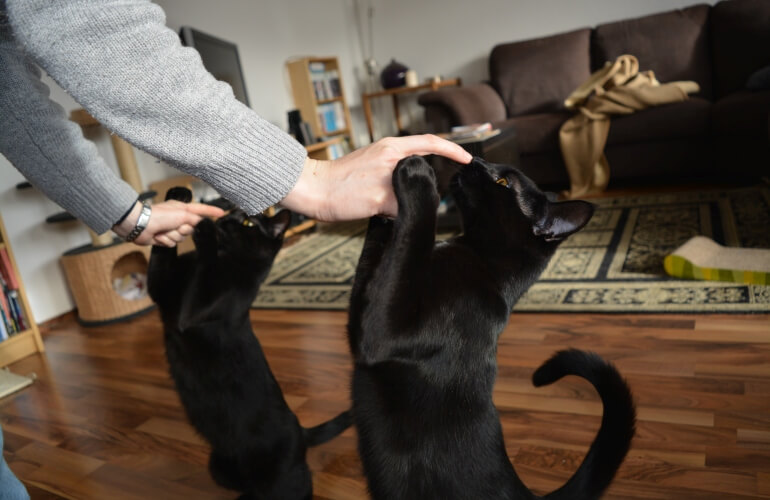There is a persistent rumor that you cannot educate cats – they have a mind of their own and therefore do what they want. Luckily, that’s not true. Of course, cats can be trained if you use the right method. I once met an animal trainer in an Australian youth hostel who talked about his life training all sorts of animals. According to his statement most animals who eat regularly can be trained fairly easily. It’s more difficult only with animals with long periods of time between meals, like with snakes.
But back to the cats: Clicker training is an effective method to teach your cats. You only need a clicker and a few treats to entice your cat to learn all sorts of things. You just have to want it.
Table of Contents
Why should you train your cats?
I have experienced some negative reactions to the suggestion of teaching an animal tricks with clicker training. Some people think it’s unnatural, after all the cat is not a circus animal, and it’s not behavior appropriate for the species. I see it differently.
Clicker training has several advantages: On the one hand, clicker training strengthens the bond between humans and animals, as it lets them work together on a common goal. The cat itself is said to enjoy the challenge and is happy about positive reinforcement it receives when it does something right. Besides, there are more useful things to teach your cat apart from “high five” or “sit”: You can also teach the cat other practical things like sitting down on a certain spot (useful if you need to know where the cat is at a particular time), or putting the cat in its carrier basket if you have to get it out of the house.

What you need
In principle, you only need one clicker and a few treats or a reward to clicker train your cats. Clickers for cats are available cheaply at Amazon* or in pet stores, but if you want to start right away, you can use another device that makes a recognizable sound that your cat won’t be used to hearing – a a whistle, a sound on your cell phone – even clicking with your tongue can replace the clicker.
The thing I like about my store-bought clicker is that it’s small and easy to hold and I can use it quickly and precisely. This is important to make sure cats get rewarded for the right action. Mine actually came included with a training book – but it’s in German*, so likely not much use to you, dear reader. However, there’s also a vast selection of English books on the topic, from Clicker Training for Cats* by Karen Pryor to The Trainable Cat: A Practical Guide to Making Life Happier for You and Your Cat* by John Bradshaw and Sarah Ellis to Clicker Training for Clever Cats: Learning can be fun!* by Martina Braun. You’re spoilt for choice!
Now that you’ve sorted out your training book, let’s talk about the treats: If you integrate clicker training into your cat’s everyday life, you should take into account that the treats at calories to your cat’s diet. It’s highly recommended to reduce the food you usually feed him to make sure he doesn’t put on weight.
If your cat doesn’t tolerate dry food, you can of course also use other forms of food like vitamin paste or small spoonfuls of wet food. The only difference is the convenience of application.
How clicker training works
The idea is simple: You reward your cat when it does something right and then “link” the trick with a word or gesture. The clicker is there to indicate immediately if something has been done right. Since it can take some time until you have taken out your treat and rewarded your cat, she may not understand what she was rewarded for. The clicking noise is almost immediate – this way your cat knows she has done something right and now she must only wait for the reward you’re preparing.
Condition your cat to the clicker
The first thing to do is to condition the cat to the clicker. Conditioning is a simple and extremely effective remedy. You’ll know the effect if you’ve ever received an electric shock from a door handle. My garage door used to shock me quite regularly, so I was conditioned to dread touching it. This is negative reinforcement, of course we want the positive kind. We’ll reward cats for behavior we want to reinforce and then they can then decide for themselves whether or not to do it.
You start by attracting the attention of your cat and with your clicker and treats ready. At first all you do is this: Click, then show the treat and give it to your cat. Usually it doesn’t take long until your cat associates the clicking sound with the treats you’re giving. Repeating this 10 times will be enough in most cases.

Clicker training with two cats
If you have two cats and want to do clicker training with them, it might be best to do the conditioning individually. I have also read some people suggesting the whole training be done individually. This can be difficult, depending on the size of your house or apartment, since cats will hear the clicking noise through doors. If you then train with one cat, the other cat will sit in front of the door, meowing pitifully. At least that was my experience.
Also interesting: Why do cats drool?
However, I have the feeling that my two boys understand which one of them is being addressed , especially if I say their name before giving a command, so clicker training with two cats at the same time is definitely possible.
Teaching a cat new tricks
Once your cat has gotten used to your clicker, it is time to make use of this new exciting tool. At the beginning the trick “sit” is relatively easy, because sooner or later your cat will sit down when you stand in front of him with a treat. Now you have to be consistent and click as precisely as possible.
Our boy Wrex sits down, CLICK!, he gets a treat, no problem. Garrus on the other hand likes to take his sweet time until his furry backside actually touches the ground. If you use the clicker before he sits properly, you are training him to “pseudo-sit”. So patience is important – at some point he will sit properly, and that’s when you click and give him a treat.
Another nice trick is “High Five”. My clicker book advises to stick treat between your ring and middle finger. After a while your cat will try to get the treat out with his paw and as soon as the paw touches your hand, use the clicker and give the reward. (Here I would make sure not to use the clicker when the claws are extended, as that’s not a very satisfying High Five on your end!) I think Wrex needed some time before he understood that he should reach for the treat with his paw – but that’s fine, he can try a lot of different things, and you just click when he does it right.
Experts suggest that after some time, cats are happy even to hear the clicking sound and finding out they did something right. The treat will then be an extra bonus – but one you should still give fairly often, just to make sure your cat won’t lose the association.
More complicated tricks
There are many more complicated tricks you can teach, which will take a little longer for your cat to learn. As an example, teaching your cat to lie down on a cushion or in her carrier box on command is maybe a bit less straightforward. In this case, you simply have to proceed incrementally and start by rewarding your cat for looking in the right direction. Once she has understood this part, you begin to demand a little more – a step in the right direction, touching a cushion or box, etc. Step by step, she’ll learn what is expected of her.
Make sure you keep your training sessions short: To practice only one trick at each session is enough and does not tire out your cat. (At some point she will have eaten enough treats for sure).
If your cat starts meowing in the middle of the session or starts to clean itself, this might point to it getting frustrated. This happens if she doesn’t manage to get enough “clicks” and can’t figure out what’s demanded of her. Here you can be a bit generous and as I said, it is worthwhile to reward small steps in the right direction.
Good luck with clicker training of your furry felines! If you like, you are welcome to share your experiences in the comments.



0 Comments